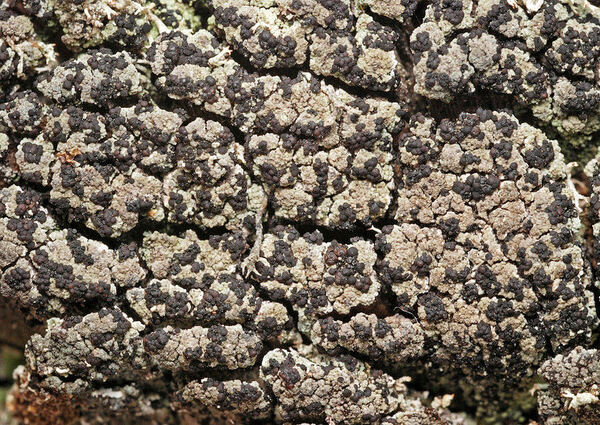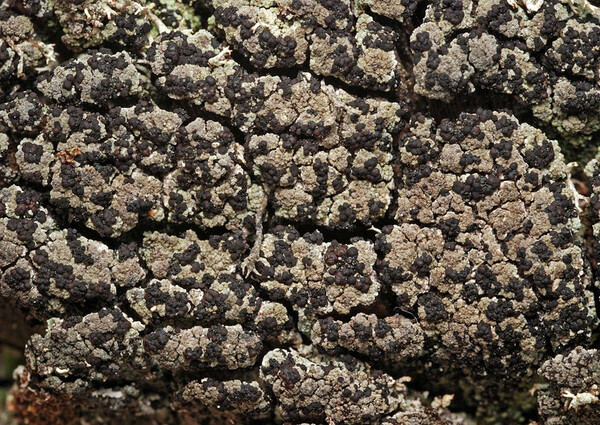Hertelidea botryosa (Fr.) Printzen & Kantvilas
Bibl. Lichenol., 88: 542, 2004. Basionym: Biatora botryosa Fr. - K. Svenska Vetensk.-Akad. Handl.: 268, 1822.
Synonyms: Lecidea botryosa (Fr.) Th. Fr.
Description: Thallus crustose, episubstratic, verrucose-areolate to minutely subsquamulose, rather thick, pale beige to dark grey, often with a greenish or brownish hue. Areoles convex to almost bullate, incised, 0.1-0.4 mm in diam., sorediate. Soralia concolorous with thallus, unclearly delimited, confluent and forming a thick, cracked, subleprose crust; soredia 40-90 µm in diam. Apothecia lecideine, rounded to somewhat deformed, usually gathered in substipitate-botryose clusters, 0.15-0.35(-0.6) mm across, with a dark brown to brown-black, sometimes grey-pruinose, flat to weakly convex disc, and a pale to dark brown, thin, usually persistent proper margin. Proper exciple of densely entangled hyphae, in section patchily dark brown sometimes with a greenish or reddish hue, with a darker brown outer edge; epithecium brown, granular, 5-15 µm high; hymenium colourless to pale brown, (35-)45-55 µm high; paraphyses sparingly branched and anastomosing, 0.7-1(-1.5) µm thick at base, 1-2.5(-4) µm thick at apex; hypothecium dark brown. Asci 8-spored, clavate, with a K/I+ blue tholus including a thin, darker K/I+ blue tubular ring-structure, Micarea-type. Ascospores 0(-1)-septate, hyaline, ellipsoid, 7-12(-16) x 3-5 µm, without a perispore. Pycnidia dark, immersed. Conidia thread-like, 13-14 x c. 1 µm. Photobiont chlorococcoid. Spot tests: K-, C-, KC-, P-, UV+ white. Chemistry: perlatolic acid.
Growth form: Crustose
Photobiont: green algae other than Trentepohlia
Reproductive strategy: mainly sexual
Commonnes-rarity: (info)
Alpine belt: absent
Subalpine belt: rather rare
Montane belt: very rare
Dry submediterranean belt: absent
Humid submediterranean belt: absent
Padanian area: absent
pH of the substrata:
1 2 3 4 5
Solar irradiation:
1 2 3 4 5
Aridity:
1 2 3 4 5
Eutrophication:
1 2 3 4 5
Poleotolerance:
0 1 2 3
Altitudinal distribution:
1 2 3 4 5 6
Rarity
absent
extremely rare
very rare
rare
rather rare
rather common
common
very common
extremely common
Loading data...
Occurrence data
Predictive map
Growth form: Crustose
Photobiont: green algae other than Trentepohlia
Reproductive strategy: mainly sexual
Commonnes-rarity: (info)
Alpine belt: absent
Subalpine belt: rather rare
Montane belt: very rare
Dry submediterranean belt: absent
Humid submediterranean belt: absent
Padanian area: absent
pH of the substrata:
| 1 | 2 | 3 | 4 | 5 |
Solar irradiation:
| 1 | 2 | 3 | 4 | 5 |
Aridity:
| 1 | 2 | 3 | 4 | 5 |
Eutrophication:
| 1 | 2 | 3 | 4 | 5 |
Poleotolerance:
| 0 | 1 | 2 | 3 |
Altitudinal distribution:
| 1 | 2 | 3 | 4 | 5 | 6 |
Rarity
absent
extremely rare
very rare
rare
rather rare
rather common
common
very common
extremely common
Loading data...
Occurrence data
Predictive map








